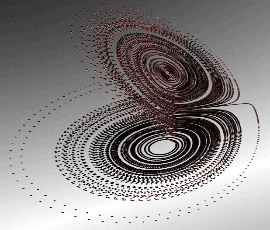Dynamical Systems and Chaos, spring 2007
Introduction to Mathematical physics:
Dynamical Systems and Chaos, spring 2007

Lecturer
Scope
6 cu.
Type
This page provides a description of the course, the references on which it will be based and the needed mathematical prerequisites. Furthermore, the web-page contains links to several web-resources for dynamical systems like free lecture notes, web-books and computer software.
Important: official lecture notes of the course and homeworks will be uploaded and updated on this web-page.
Course structure
Lectures are scheduled on
Thursdays 14-16h and exercise sessions on Tuesdays 14-16h
in Room C123 Exactum Building (Department of Mathematics and Statistics)
First lecture: Thursday, February the 1st, 2007.
Important: students who cannot attend the course may consider taking it as a reading course. The reading assignment and the examination date can be agreed directly with the lecturer.
Course description
Dynamical systems are mathematical models describing the evolution of systems in terms of equation of motion and initial values. Examples are mechanics in physics, population dynamics in biology and chemical kinetics in chemistry. Dynamical systems theory is also finding an increasing number of applications in social sciences as mathematical economy and finance.
The course will focus on models based on ordinary differential equations (ODE). Under rather general conditions, ODE are known to have unique solutions for any complete set of initial data. In the general case of non-linear dynamics, fully deterministic solutions may become unpredictable for practical purposes due a to sensitive dependence on the initial conditions. This striking phenomenon is called chaos .
The purpose of the course is to illustrate tools and techniques to characterize qualitative properties of the solutions like dependence on initial data, large time behaviour and sensitivity to variation of the parameters. Reduction and perturbative methods for quantitative construction of the solutions will be also illustrated.
The emphasis of the course will be on concrete examples and geometric thinking. Theorems will be stated but the main interest will be to show their meaning and relevance in the treatment of concrete examples.
Contents
Linear systems, fixed points and cycles in 2-D, simple bifurcations in 2-D, flows in 3-D chaos and Ljapunov exponents. Methods for simplifying dynamical systems: central manifold, normal forms and multi-scale perturbation theory.
Prerequisites
The course is intended for undergraduate students of mathematics, physics, and biology. Prior courses in advanced calculus and linear algebra are required (Diff.Int. 1-2 and Lineaarialgebra 1, or Mapu 1-2). Background material will be on request discussed during the course.
References
The course will follow the lecture notes by Nils Berglund
- Geometrical theory of dynamical systems, Nils Berglund (2001),
- Perturbation theory of dynamical systems, Nils Berglund (2001)
which can be freely downloaded from arXiv.org. A second reference will be
- Edward Ott Chaos in Dynamical Systems Cambridge University Press (1993)
There exists a vast literature on dynamical systems. Below a selected list of standard references can be found
- D.K. Arrowsmith, C.M. Place: An Introduction to Dynamical Systems. Cambridge University Press (1990).
- S.H. Strogatz: Nonlinear Dynamics and Chaos with Applications to Physics, Biology, Chemistry and Engineering. Addison-Wesley, Studies in Nonlinearity (1994).
- M.W. Hirsch, S. Smale, R. Devaney: Differential Equations, Dynamical Systems and an Introduction to Chaos. Academic Press (2004).
An good introduction to the theory of ordinary differential equations can be found in
- V.I. Arnold: Ordinary Differential Equations. MIT Press (1978) or Springer-Verlag (1992).
More advanced textbooks on dynamical systems and chaos:
- V.I. Arnold: Geometrical Methods in the Theory of Ordinary Differential Equations. Springer-Verlag Berlin (1988).
- A. Katok, B. Hasselblatt: Introduction to the Modern Theory of Dynamical Systems. Cambridge University Press (1997).
- S. Wiggins: Introduction to Applied Nonlinear Dynamical Systems and Chaos. Springer (1990).
- J. Guckenheimer, P. Holmes: Nonlinear Oscillations, Dynamical Systems, and Bifurcations of Vector Fields. Springer-Verlag, Applied mathematical sciences 42 (1983).
- T. Bohr, M.H. Jensen, G.Paladin, A. Vulpiani Dynamical Systems Approach to Turbulence. Cambridge University Press (1998).
Dynamical systems resources on the web
A lot of interesting material on dynamical systems including lecture notes, web-books and software applications are freely available from the web. A general reference is DSWeb the dynamical system web, a community service of SIAM.
Some other useful links are listed below.
Online lecture notes and textbooks
- Ordinary Differential Equations and Dynamical Systems, Gerald Teschl, University of Vienna: lecture notes.
- Complex systems, Göran Lindblad, Royal Institute of Technology (KTH) Stockholm: lecture notes.
- Systèmes Dynamiques et Équations différentielles, Claude Viterbo, lecture notes (2004) (in French).
- Chaos on the Web, Michael Cross, California Institute of Technology: lecture notes and demos.
- lecture notes from the historical archive of the ICTP school on dynamical systems.
- The Chaos hypertextbook, Glen Elert: hypertext.
- Dynamical Systems and Fractals David J. Wright, Oklahoma State University : hypertext.
- Classical and quantum chaos: a cyclist treatise, Predrag Cvitanović, Georgia Institute of Technology: web-book.
- Invitation to Dynamical Systems Edward R Scheinerman, Johns Hopkins University: book.
Review articles
- The quadratic family as a qualitatively solvable model of chaos, Michail Lyubich, Notices of the AMS, 47(9) (2000).
- Developments in Chaotic Dynamics Lai-Sang Young, Notices of the AMS, 45(10) (1998).
Software and Computer applications
- G95 a free, open source Fortran 95 compiler.
- DsTool: a dynamical system toolkit created at the Center for Applied Mathematics, Cornell University. An Rpm package is also available.
- XPP-aut software package for solving ODE's.
- AUTO-97 software package AUTO for continuation and bifurcation problems in ODE's.
- Differential Equations Mathematica Laboratory at Delta College, a tutorial to the use of Mathematica for solving ODE's.
- The Dynamical Systems and Technology Project at Boston University.
- A collection of deb-packages for scientific computing is available from www.debian.org